Analysis of the 2007-08 Budget Bill: Perspectives and Issues
The Governor’s budget proposes total spending in 2007-08 of $130.8 billion, including $103.1 billion from the state’s General Fund and $27.7 billion from its special funds (see Figure 1). This total budget-year spending is $4.2 billion higher than current-year spending—an increase of 3.3 percent. Of total budget-year spending, General Fund spending accounts for about 80 percent. This proposed spending level translates into $3,430 for every man, woman, and child in California, or $358 million per day.
|
|
|
Figure 1
Governor’s Budget Spending Totals |
|
(Dollars in Millions) |
|
|
|
|
Change |
|
|
2006-07 |
2007-08 |
Amount |
Percent |
|
Budget Spending |
|
|
|
|
|
General Fund |
$102,137 |
$103,141 |
$1,004 |
1.0% |
|
Special fundsa |
24,509 |
27,685 |
3,176 |
13.0 |
|
Totals |
$126,646 |
$130,825 |
$4,180 |
3.3% |
|
|
|
a Does not include
Local Public Safety Fund expenditures of $2.8 billion in 2006-07 and
$3 billion in 2007-08. These amounts are not shown in the Governor's
budget. |
|
Detail may not total
due to rounding. |
|
|
Figure 2 shows the allocation of the proposed $130.8 billion of total state spending in 2007-08 among the state’s major program areas. Both General Fund and special funds expenditures are included in order to provide a meaningful comparison of state support among broad program categories, since special funds provide the bulk of support in some areas (such as transportation).
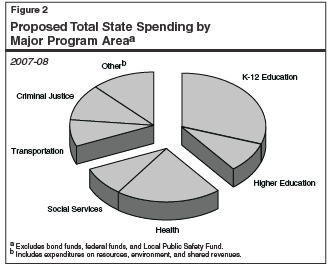
The figure shows that K-12 education receives the largest share of spending—30 percent of the total. (It also should be noted that K-12 education spending receives additional funding from local sources.) When higher education is included, education’s share rises to 40 percent. Health and social services programs account for 29 percent of proposed total spending, while transportation and criminal justice together account for roughly 19 percent. The “other” category (12 percent) primarily includes general-purpose fiscal assistance provided to local governments in the form of shared revenues.
Background. The General Fund is the main source of support for state programs, funding a wide variety of activities. For example, it is the major funding source for K-12 and higher education programs, health and social services programs, criminal justice programs, as well as tax relief provided through the budget.
Proposed Spending. The Governor proposes General Fund spending of $103.1 billion for 2007-08, an increase of 1.0 percent. As has been the case in recent years, the year-to-year changes in many programs are being affected by special factors, such as transfers of programs, funding redirections, and one-time actions. As shown in Figure 3:
-
General Fund spending for K-12 Proposition 98 programs is proposed to be $36.9 billion, a 0.5 percent increase from the current year. Total combined state and local funding for K-12 Proposition 98 is proposed to increase by a larger 2.9 percent. The relatively low growth rate for total funding reflects the Governor’s proposal to shift $627 million in home-to-school transportation expenditures from Proposition 98 to the Public Transportation Account (PTA). General Fund spending is further depressed by the administration’s assumption that local property revenues will increase by 10 percent in 2007-08, despite the real estate slowdown. Local property tax growth offsets, dollar-for-dollar, state General Fund spending for Proposition 98. The budget covers a 4 percent cost-of-living adjustment (COLA) for general apportionment and various categorical programs and provides additional support for the California Work Opportunities and Responsibly to Kids (CalWORKs)-related childcare.
-
General Fund Proposition 98 spending for community colleges is proposed to total $4.2 billion, a 4.6 percent increase from the current year. This increase funds a 4 percent COLA and a 2 percent increase in enrollment. It also covers the full-year costs of the student fee reduction that takes place in the middle of 2006-07.
-
University of California (UC) and California State University (CSU) combined funding is proposed to be $6.2 billion, a 6 percent increase from the current year. The spending total covers base increases of 4 percent and enrollment increases of about 2.5 percent for both segments.
-
Medi-Cal funding is proposed to total $14.6 billion, a 7.2 percent
increase from the current year. The increase covers cost and utilization
in the program. The potential impact of the Governor’s health care
reform proposal is not included in the budget totals.
-
CalWORKs spending would decline 34 percent to $1.3 billion in the budget year. The decline reflects a suspension of the January 2007 COLA, the impacts of the Governor’s proposals related to time limits and sanctions, and the shift of certain child-care costs to Proposition 98.
-
Supplemental Security Income/State Supplementary Payment (SSI/SSP) spending is proposed to total $3.9 billion, an increase of 9.9 percent. The above-average increase primarily results from the half-year effect of funding the statutory January 2008 COLA.
-
In-Home Supportive Services (IHSS) spending is proposed to total $1.5 billion, a 1.9 percent increase from the current year. The below-average increase reflects the full-year implementation of quality assurance initiatives and the capping of state participation in provider wages.
-
Criminal justice funding is proposed to increase to $13 billion, an 8.7 percent increase from the current year. The funding covers price increases, inmate growth, compliance with various court orders, and a new program to manage sex offenders.
-
Transportation spending from the General Fund is proposed to total $1.6 billion, a decline of 48 percent from the current year. Part of the reason for the decline is that the current-year total includes one-time funding related to large Proposition 42 loan repayments. In addition, the budget-year total reflects a one-time shift of $339 million in debt-service costs from the General Fund to a special fund (the PTA).
|
|
|
Figure 3
General Fund Spending by Major Program
Area |
|
(Dollars in Millions) |
|
|
|
|
Proposed 2007-08 |
|
|
Actual 2005-06 |
Estimated 2006-07 |
Amount |
Percent Change |
|
Education Programs |
|
|
|
|
|
K-12 Proposition 98 |
$34,582 |
$36,658 |
$36,851 |
0.5% |
|
Community Colleges Proposition 98 |
3,670 |
4,040 |
4,224 |
4.6 |
|
UC/CSU |
5,444 |
5,895 |
6,246 |
6.0 |
|
Other |
3,939 |
4,792 |
5,193 |
8.4 |
|
Health and Social
Service Programs |
|
|
|
|
Medi-Cal |
$12,358 |
$13,649 |
$14,629 |
7.2% |
|
CalWORKs |
1,963 |
2,014 |
1,324 |
-34.3 |
|
SSI/SSP |
3,427 |
3,543 |
3,893 |
9.9 |
|
In-Home Supportive Services |
1,355 |
1,444 |
1,471 |
1.9 |
|
Other |
7,238 |
9,170 |
8,558 |
-6.7 |
|
Criminal Justice |
$10,090 |
$11,924 |
$12,955 |
8.7% |
|
Transportation |
$1,699 |
$2,993 |
$1,558 |
-47.9% |
|
All Other |
$5,827 |
$6,016 |
$6,238 |
3.7% |
|
Totals |
$91,592 |
$102,137 |
$103,141 |
1.0% |
|
|
|
Detail may
not total due to rounding. |
|
|
Background. Special funds are used to allocate certain tax revenues (such as gasoline and certain cigarette tax receipts) and various other income sources (including many licenses and fees) for specific functions or activities of government designated by law. In this way, they differ from General Fund revenues, which can be allocated by the Legislature among a variety of programs. About 35 percent of special funds revenues come from motor vehicle-related levies, another 22 percent comes from sales taxes, and the remainder comes from numerous sources; including a 1 percent surcharge on personal income taxes, and from tobacco taxes, charges, and fees.
Proposed Spending. In 2007-08, the Governor proposes special funds spending of $27.7 billion (see Figure 4). This is a 13 percent increase from the current-year total. The large increase reflects a variety of funding shifts, some of which were discussed above. The 17.1 percent increase in transportation funding, in part, reflects debt-service payments related to transportation bonds. The large increase in the Department of Mental Health reflects the ramp-up of spending associated with voter approval of Proposition 63 in 2004. The large increase in education is largely related to the use of PTA funds to support General Fund spending in K-12 transportation.
|
|
|
Figure 4
Special Funds Spending by Major Program Area |
|
(Dollars in Millions) |
|
|
|
|
Proposed 2007-08 |
|
|
Actual 2005-06 |
Estimated 2006-07 |
Amount |
Percent Change |
|
Transportation |
$6,361 |
$6,489 |
$7,601 |
17.1% |
|
Local government subventions |
6,168 |
6,427 |
6,222 |
-3.2 |
|
Resources related |
2,433 |
3,001 |
3,102 |
3.4 |
|
Department of Mental Health |
168 |
517 |
1,511 |
192.1 |
|
Public Utilities Commission |
1,230 |
1,277 |
1,270 |
-0.6 |
|
Department of Education |
45 |
71 |
675 |
851.8 |
|
All other |
6,311 |
6,726 |
7,304 |
8.6 |
|
Totals |
$22,716 |
$24,509 |
$27,685 |
13.0% |
|
|
|
Detail may not total
due to rounding. |
|
|
It should be noted, that the budget’s special funds spending total for 2007-08 excludes expenditures of roughly $3 billion from the Local Public Safety Fund (LPSF). Such spending is also excluded from the current-year and prior-year totals.
Our view is that LPSF revenues are state tax revenues expended for public purposes, and should be counted. This treatment is consistent with how the budget treats other dedicated state funds, such as the Motor Vehicle License Fee Account (which, like the LPSF, is constitutionally dedicated to local governments) and the Cigarette and Tobacco Products Surtax Fund (Proposition 99), both of which the budget does include in its spending totals. However, although we believe that such spending does constitute state spending, we do not include it in our figures in order to facilitate comparisons with the budget.
In addition to the $130.8 billion of proposed 2007-08 spending from the General Fund and special funds, the budget also proposes $58 billion in spending from federal funds and another $12.6 billion from bond proceeds. If expenditures from bond proceeds and federal funds are included in total state spending, proposed 2007-08 spending exceeds $201 billion.
As noted above, about $58 billion in federal funds are proposed to be spent through the state budget in 2007-08. (This is about one-fourth of the $232 billion in total federal funds allocated to California. The remaining three-fourths are allocated directly to local governments, businesses, or individuals within the state.) About $33 billion (57 percent) of the total federal funds in the budget are for various health and social services programs, such as Medi-Cal, CalWORKs, and IHSS. Education receives another $12.4 billion (22 percent) of the total, and transportation is expected to receive $4.2 billion (7 percent). The remaining $8.2 billion (14 percent) is spread across all other program areas.
Budgetary Treatment. Bonds are primarily sold by the state to finance large capital outlay projects, such as school facilities, water projects, and state buildings. From a budgetary perspective, the cost of bond programs is reflected when the actual debt-service payments (comprised of bond-related principal and interest payments) are made. For 2007-08, the budget proposes General Fund debt-service expenditures of $4.7 billion, of which $3.9 billion is for general obligation (GO) bonds and about $780 million is for lease-revenue bonds.
Although this way of treating bonds makes sense from a budgetary standpoint, tracking bond fund expenditures themselves still is useful as an indication of the actual volume of “brick and mortar” activities that is taking place with respect to capital projects.
Spending of GO Bond Proceeds. The January budget proposal estimates that the state will spend $12.6 billion in GO bond proceeds for capital projects in 2007-08. This includes $6.9 billion for education, $2.8 billion for transportation, and $2.9 billion for resources and other areas. This total is up 32 percent from the $9.5 billion in current-year spending. The comparatively larger amount in the budget year reflects $8.7 billion of spending from the $43 billion of bonds authorized by the voters in November 2006. About $3.5 billion (40 percent) of the spending of new bond monies is for education facilities, $2.8 billion (32 percent) is for transportation projects, and the remaining $2.4 billion (28 percent) is for resources, flood control, and housing.
Spending of Lease-Revenue Bond Proceeds. In addition to GO bonds, the state also uses lease-revenue bonds to finance the construction and renovation of capital facilities. Lease-revenue bonds do not require voter approval, and their debt service is paid from annual lease payments made by state agencies using the facilities financed by the bonds (funded primarily through General Fund appropriations). For 2007-08, the budget proposes $258 million in new spending from lease-revenue bond proceeds for such purposes as the construction of forest fire stations.
In addition to borrowing for capital outlay purposes, the state has undertaken significant borrowing in recent years to help address budgetary shortfalls. At the peak, the state had more than $25 billion in budget-related debt outstanding from private investors, schools, local governments, transportation, and other special funds. The amount of outstanding borrowing has subsequently fallen, and will continue to decline through the budget year under the Governor’s budget proposal (which includes a total of $1.6 billion in supplemental payments on outstanding deficit-financing bonds). Even after these repayments, however, the state will be left with $18 billion in budget-related debt at the close of 2007-08 (see Figure 5). This consists of:
-
About $12 billion from private credit markets, about $5 billion of which result from deficit-financing bonds, with the remainder from tobacco-related bonds and other sources.
-
Around $1.5 billion from special funds, about one-half of which is related to deferred Proposition 42 payments.
- About $1 billion from noneducation local governments related to deferred mandate payments.
- About $1.1 billion in settle-up payments owed to Proposition 98 education, and another $2.5 billion owed to K-14 education under the terms of the settlement agreement reached last year regarding the 2004-05 suspension of the minimum guarantee.
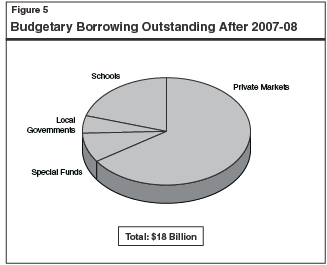
As shown in Figure 6, scheduled repayments of this budgetary borrowing will result in annual General Fund costs of $4.1 billion in 2007-08, rising to a peak of $4.5 billion in 2008-09. These repayment amounts are included in our projections. The significant decline in payments in 2010-11 is due to the administration’s assumption that the Proposition 57 deficit-financing bonds will be paid off in 2009-10.
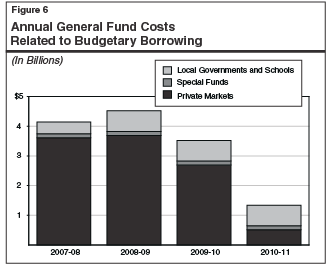
Background. In 1979, California’s voters established a state appropriations limit (SAL) when they approved Proposition 4. The SAL places an “upper bound” on the amount of tax proceeds that the state can spend in any given year, and grows annually by a population and cost-of-living factor. Most state appropriations are subject to SAL; however, certain appropriations are exempt—including those for subventions to schools and local governments, capital outlay, and tax relief. If actual tax proceeds exceed SAL over a two-year period, the excess must be divided among taxpayer rebates and Proposition 98 education funding.
Expenditures Projected to Be Well Below the Limit. Due to the downturn in the state’s economy and its adverse effects on the state’s revenues, expenditures supported by taxes fell during the early years of this decade. (While the state used borrowed funds to support spending in excess of revenues during this period, spending supported by borrowed funds does not count against SAL.) Although tax-supported spending has rebounded in recent years, a large gap still remains between the limit and spending subject to it. In 2006-07, appropriations subject to the limit are $12.1 billion below the limit, and in 2007-08, the gap narrows slightly to $11.9 billion.
Each year, the budget includes funds for cost-of-living adjustments, commonly referred to as COLAs. The purpose of these adjustments is to compensate for the adverse effects of inflation on the purchasing power of the previous year’s funding level. Existing law authorizes automatic COLAs for over two dozen programs, mostly in the areas of K-12 education, social services, health, trial courts, and the judiciary. These are generally referred to as statutory COLAs. Other programs receive COLAs on a discretionary basis, through decisions made during the annual budget process. The major General Fund COLAs in the 2007-08 proposed budget are shown in Figure 7. These COLAs are based on a variety of different statutory formulas. For example, the COLAs that are applied to social services programs are related to components of the California Consumer Price Index, COLA adjustments for the trial courts are related to growth in the SAL factor, and general apportionments and some categorical programs in Proposition 98 are linked to the U.S. gross domestic product price deflator for state and local governmental purchases.
As indicated in Figure 7 and noted above, the budget proposes COLAs for most, but not all, areas. Programs receiving COLAs include:
-
K-12 and community college education, where general apportionments and most categorical programs receive a 4 percent statutory COLA.
- UC and CSU, which receive 4 percent COLAs. These base increases are consistent with the Governor’s compact with these two higher education segments.
-
The trial courts, which receive a 5.4 percent increase, based on the growth in the SAL adjustment factor.
-
Selected health programs, particularly long-term care providers and regional center vendors.
-
Selected state operations, which receive various price increases to cover nonwage costs. (Subsequent to the release of the January 10 budget, the administration proposed reducing these price increases in order to cover increased employee compensation costs for correctional officers.)
|
|
|
Figure 7
General Fund COLAs—2007-08 Governor’s
Budget |
|
Program/Department |
COLA
Percent |
Statutory or Discretionary |
Funded |
Cost
(Millions) |
|
Education |
|
|
|
|
|
Proposition 98 |
|
|
|
|
|
Apportionments |
4.04% |
Statutory |
Yes |
$1,384 |
|
Categorical programsa |
4.04 |
Statutory |
Yes |
729 |
|
Non-Proposition 98 K-12 Education |
|
|
|
|
|
Child nutrition programs |
4.04 |
Statutory |
Yes |
1 |
|
Higher Education |
|
|
|
|
|
University of Californiab |
4.0 |
Discretionary |
Yes |
117 |
|
California State Universityb |
4.0 |
Discretionary |
Yes |
109 |
|
Judicial Branch |
|
|
|
|
|
Trial Courts |
5.36% |
Statutory |
Yes |
$147 |
|
Health |
|
|
|
|
|
Medi-Cal |
|
|
|
|
|
County eligibility administration |
3.26% |
Discretionary |
Yes |
$18 |
|
Long-term care rate adjustments |
Various |
Statutory |
Yes |
111 |
|
Certain clinics |
2.9 |
Statutory |
Yes |
18 |
|
Managed Care plans |
Various |
Discretionary |
Yes |
3 |
|
Department
of Alcohol and Drug Programs |
|
|
|
— |
|
Drug Medi-Cal |
3.0 |
Statutory |
Yes |
3 |
|
Department of Mental Health |
|
|
|
|
|
Mental Health Managed Care Program |
— |
Discretionary |
No |
— |
|
Department of Developmental Services |
|
|
|
|
|
Various regional center vendors |
Various |
Statutory |
No |
— |
|
Social Services |
|
|
|
|
|
CalWORKs July 2007 |
3.7% |
Statutory |
No |
— |
|
SSI/SSP January 2008 |
3.7 |
Statutory |
Yes |
$172 |
|
Foster Care |
3.7 |
Discretionary |
No |
— |
|
State Departments |
|
|
|
|
|
Operations cost |
1.35%c |
Discretionary |
Yes |
$57 |
|
Total |
|
|
|
$2,869 |
|
|
|
a Most of
the large categorical programs have statutory cost-of-living
adjustments (COLAs). All of the statutory COLAs, and many of
the discretionary COLAs, are proposed to receive funding. |
|
b
The Governor has a
nonbinding compact with higher education that contains
specified increases for cost-of-living and enrollment. |
|
c Reflects
the administration’s January 19th proposal to
reduce most departments’ operations COLA by one-half. The
January 10 budget provided a 2.7 percent COLA for
departments at a cost of $103 million. |
|
|
COLAs Not Provided for CalWORKs or Foster Care. While the budget funds the January 2008 COLA for SSI/SSP, it does not include funding for the July 2007 COLA for the CalWORKs program. Funding is also not provided for a foster care COLA.
Total Spending. Figure 8 shows total state spending over the decade 1997-98 through 2007-08 (as proposed), and breaks down this spending according to General Fund and special funds spending. It indicates, for example, that total spending grows over this period from $67.1 billion to $130.8 billion.
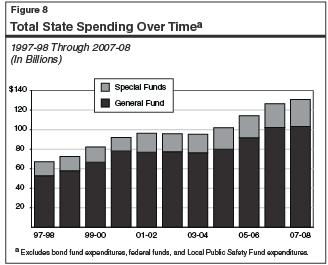
Figure 9 shows cumulative percent changes in various measures of state spending over the past decade. It indicates that total state spending increased by over 43 percent between 1997-98 and 2001-02, reflecting funding increases in education, health, and a variety of other areas in the budget. Spending then flattened for the next two years, as the state reduced program spending and deferred costs to help cope with the major fiscal imbalances that occurred following the 2001-02 revenue downturn. Spending grew sharply in 2005-06 and 2006-07, reflecting such factors as funding increases in education, the conclusion of a property tax shift, and repayments of budgetary debt. Under the budget plan, funding would increase further in 2007-08, but at a slower pace than the two previous years. Total spending over the entire period would about double, reflecting an average annual growth rate of roughly 7 percent.
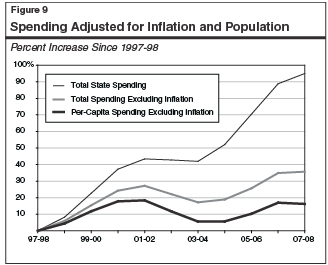
Real and Real Per-Capita Spending. Part of the spending growth discussed above is related to the effects of a growing population and rising prices over time. Figure 9 shows total state spending after adjusting for these factors. It indicates that:
-
After adjusting for inflation, real spending has grown by roughly 36 percent over the entire period, or an annual average growth rate of roughly 3.1 percent.
-
Real per-capita spending—which adjusts for both inflation and population growth—would increase by about 16 percent over the period under the Governor’s plan, for an average annual rate of 1.5 percent.
Spending Relative to the State’s Economy. Figure 10 shows how state spending has varied over recent years as a percentage of total California personal income (which is a broad indicator of the size of the state’s economy). From 1997-98 through 2001-02, total state spending increased steadily as a share of personal income—from 7.3 percent to 8.4 percent. As shown in the figure, growth in General Fund spending accounted for virtually all of this increase.
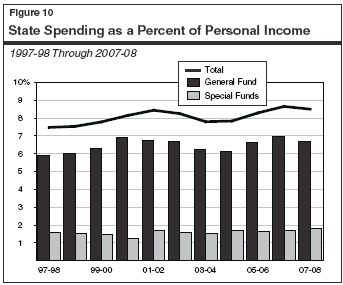
After 2001-02, however, total state spending as a percentage of personal income reversed direction, and dropped to below 8 percent in both 2003-04 and 2004-05. This reduction reflects both budget savings and numerous one-time funding shifts, deferrals, and other forms of budgetary borrowing. The one-time factors included an accounting change to Medi-Cal, increased federal funds (which temporarily offset state spending), savings related to a restructuring of debt-service payments, and a two-year shift of property taxes from local governments to schools (resulting in savings to the General Fund). The spending totals for 2004-05 also reflect a $2 billion offset related to the deficit-financing bonds authorized by the voters in March 2004.
After climbing for the next two years to a peak of 8.7 percent in 2006-07, the ratio of total state spending to California personal income under the Governor’s budget plan would decline to 8.5 percent in 2007-08, as personal income in the budget year is projected to rise faster than spending.
Return to Perspectives and Issues Table of Contents,
2007-08 Budget Analysis